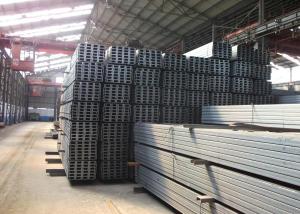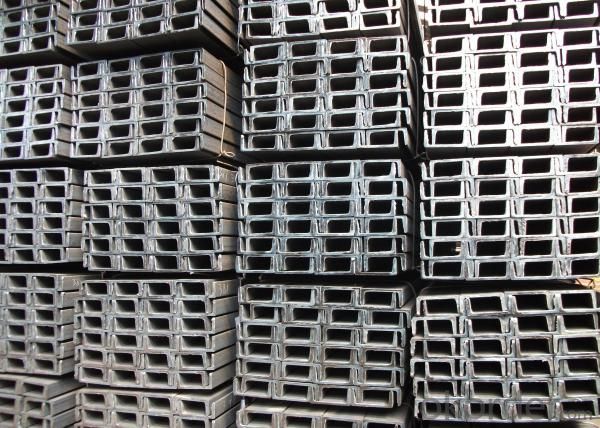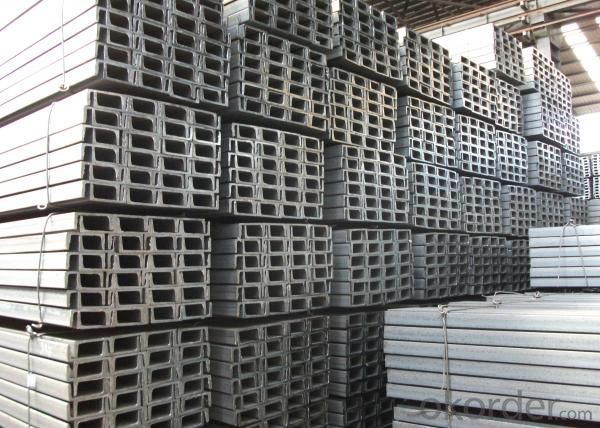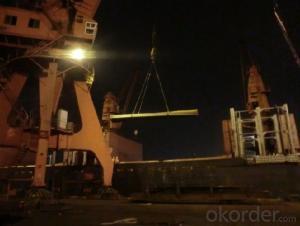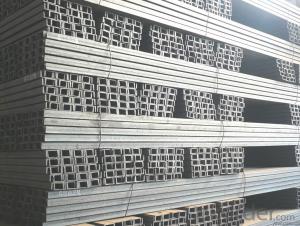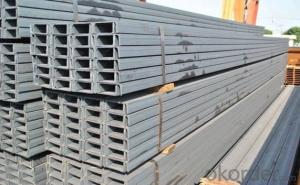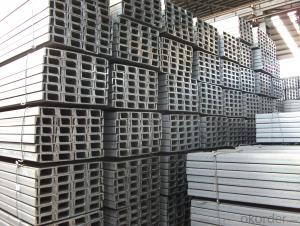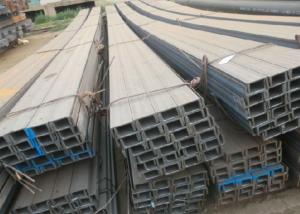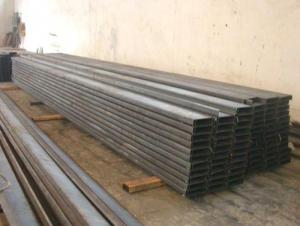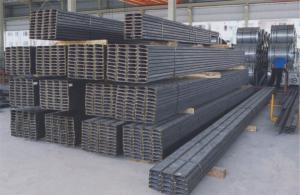Structure Steel U Channel
- Loading Port:
- Xingang Port
- Payment Terms:
- TT or LC
- Min Order Qty:
- 25mt m.t.
- Supply Capability:
- 80000-100000MTS/YEAR m.t./month
OKorder Service Pledge
OKorder Financial Service
You Might Also Like
Specifications of Structure Steel U Channel:
1.We provide chinese and japanese standard structure steel u channel for structure construction
2. The prices can be quoted on the theoretical weight or actual weight, just as customer's requriements.
3.Those material includes: Q235/SS400/ST37-2 Q345/ST5
4.The sections of GB Standard Structure Steel U Channel are as followings in the table-1:
GB U CHANNEL | Standard
h
| Sectional
b
| Dimension
s
|
t
| Mass:
Kg/m
|
| (mm) | (mm) | (mm) | (mm) |
|
50X37 | 50 | 37 | 4.50 | 7.0 | 5.438 |
63X40 | 63 | 40 | 4.80 | 7.5 | 6.634 |
80x43 | 80 | 43 | 5.00 | 8.0 | 8.045 |
|
|
|
|
|
|
100x48 | 100 | 48 | 5.30 | 8.5 | 10.007 |
120x53 | 120 | 53 | 5.50 | 9.0 | 12.059 |
140x58 | 140 | 58 | 6.00 | 9.5 | 14.535 |
140x60 | 140 | 60 | 8.00 | 9.5 | 16.733 |
|
|
|
|
|
|
160x63 | 160 | 63 | 6.50 | 10.0 | 17.240 |
160x65 | 160 | 65 | 8.50 | 10.0 | 19.752 |
|
|
|
|
|
|
180x68 | 180 | 68 | 7.00 | 10.5 | 20.174 |
180x70 | 180 | 70 | 9.00 | 10.5 | 23.000 |
|
|
|
|
|
|
200x73 | 200 | 73 | 7.00 | 11.0 | 22.637 |
200x75 | 200 | 75 | 9.00 | 11.0 | 25.777 |
|
|
|
|
|
|
220x77 | 220 | 77 | 7.00 | 11.5 | 24.999 |
220x79 | 220 | 79 | 9.00 | 11.5 | 28.453 |
|
|
|
|
|
|
250x78 | 250 | 78 | 7.00 | 12.0 | 27.410 |
250x80 | 250 | 80 | 9.00 | 12.0 | 31.335 |
250x82 | 250 | 82 | 11.00 | 12.0 | 35.260 |
|
|
|
|
|
|
280x82 | 280 | 82 | 7.50 | 12.5 | 31.427 |
280x84 | 280 | 84 | 9.50 | 12.5 | 35.823 |
280x86 | 280 | 86 | 11.50 | 12.5 | 40.219 |
|
|
|
|
|
|
300x85 | 300 | 85 | 7.50 | 13.5 | 34.463 |
300x87 | 300 | 87 | 9.50 | 13.5 | 39.173 |
300x89 | 300 | 89 | 11.50 | 13.5 | 43.883 |
Table-1
Note: we are also competent to supply structure steel u channel as per other sections, which depends on the customer's requirements for the quantity.
5.The chemical composition of structure steel u channel as shown in the table-2:
Alloy No | Grade | Element(%) | ||||
C | Mn | S | P | Si | ||
Q235 | B | 0.12-0.20 | 0.3-0.7 | ≦0.045 | ≦0.045 | ≦0.3 |
Table-2
Applications of Structure Steel U Channel:
1.Character: The Structure Steel U Channel belongs to carbon structural steel which is applied to in the field of construction and machinery.
2.The structure steel u channel is usually used for architectural structure, and they could be welded in order to support or hang a variety of facilities. They are usually used in combination with I beam.
3.Generally, the structure steel u channel must possess perfect welding property,riveting property as well as mechanical property.
Package & Delivery of Structure Steel U Channel:
The structure steel u channel will be packed in bundle with steel wire at each end of every bundle and color marking in order to help the customer to recognize his goods more easily at sight.
And structure steel u channel could be loaded into 20ft or 40ft container, or by bulk cargo.If the weight of each bundle reaches less than 3.5 mt, the loading by break bulk cargo should be choosed.When the weight of each bundle reaches less than 3mt, the loading by container should be choosed.
As for the transportaion from mill to loading port, the truck will be usually used. And the maximum quantity for each truck is 40mt.
All in all, we could do in accordance with customer's request.
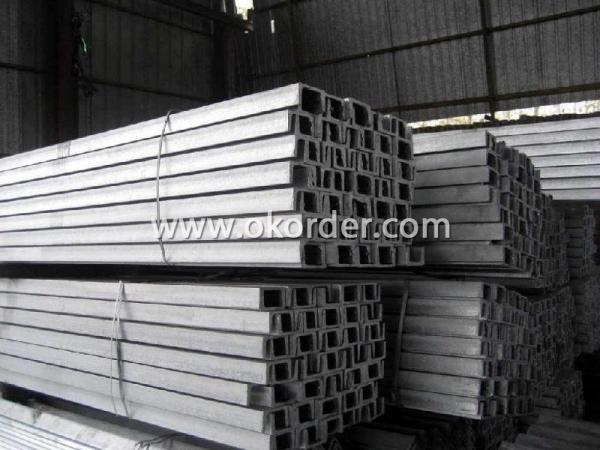
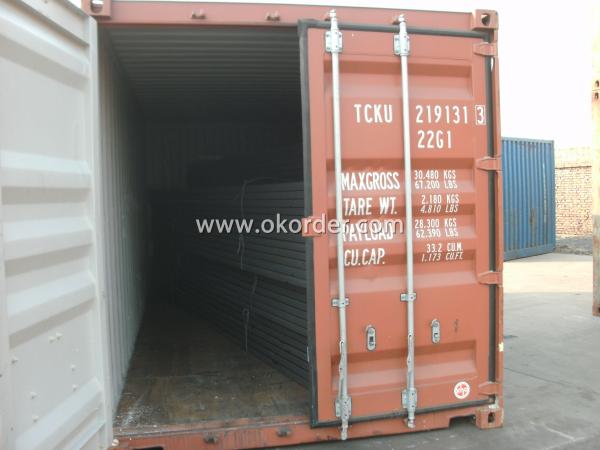
Production Flow of Structure Steel U Channel:
1.The steel billet shall be heated in the high temperature furnace.
2.The heated steel billet shall be rolled five to nine times with the aim of shaping the general figure of steel u channel.
3.The rolled steel u channel should be put onto the cooling bed to make the temperature low.
4.The steel u channel should be straighted on the straightener.
5.The straighted steel u channel will be cut into meters by saw, as per customer's requirements.
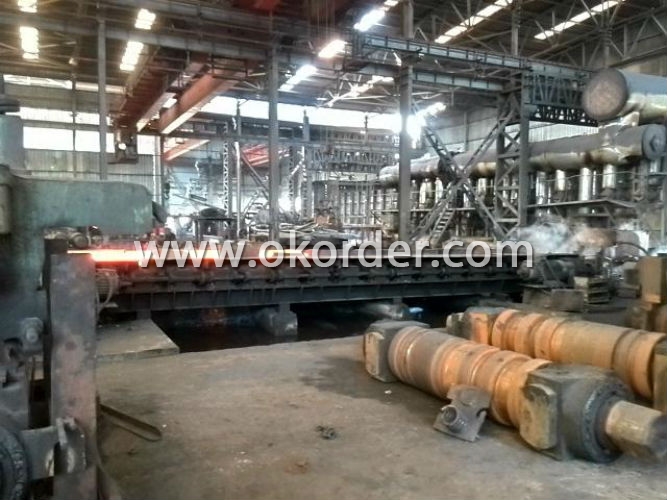
- Q: Channel steel, I-steel, round bar, angle steel, Fang Gang price is per ton to count or by rice? How about tons and meters? The formula is best
- Base area * * 7.85 (7.85 is the specific weight of steel)If the unit of computation is mm, it is "gram""If the unit of work is centimeter, it is "kilogram""If the unit of measurement is rice, it is ton"
- Q: Can steel channels be painted?
- Steel channels can indeed be painted, and this painting process can offer a protective layer that prevents corrosion and enhances their visual appeal. However, there are a few vital considerations to bear in mind when painting steel channels. Firstly, it is crucial to ensure that the surface of the channels is thoroughly clean and devoid of any dirt, grease, or rust. To achieve this, it is recommended to employ a wire brush or sandpaper to eliminate any loose particles and create a smooth surface for the paint to adhere to. Furthermore, it is of utmost importance to utilize a primer specifically formulated for metal surfaces. This will ensure appropriate adhesion and durability of the paint. Once the primer has been applied and allowed to dry, a suitable paint can be selected to coat the steel channels. It is essential to choose a paint that is compatible with metal surfaces and offers resistance to corrosion and weathering. In some cases, multiple coats of paint may be necessary to achieve the desired finish and durability. Overall, by properly preparing the surface and utilizing appropriate primers and paints, steel channels can be effectively painted to both protect and enhance their appearance.
- Q: How do steel channels contribute to the overall safety of a project?
- Steel channels play a crucial role in enhancing the overall safety of a project in several ways. Firstly, these structural components provide robust support and reinforcement to various structures, such as buildings, bridges, and infrastructure projects. The strength and durability of steel channels make them capable of withstanding heavy loads and extreme weather conditions, minimizing the risk of structural failure or collapse. Moreover, steel channels are fire-resistant, which is a significant advantage in terms of safety. In the event of a fire, steel channels can withstand high temperatures for an extended period, offering valuable time for evacuation and minimizing the spread of flames. This fire resistance property makes steel channels highly suitable for projects where fire safety is a critical concern, such as high-rise buildings, industrial facilities, and transportation infrastructure. Another important contribution of steel channels to project safety is their ability to resist corrosion. Steel channels are typically made from galvanized or stainless steel, which are highly resistant to rust and corrosion. This resistance ensures the structural integrity of the channels over time, reducing the risk of deterioration and potential hazards. Consequently, projects utilizing steel channels can enjoy a longer lifespan and require less maintenance, ultimately enhancing safety and reducing the need for costly repairs. Additionally, steel channels offer versatility in design and construction. They can be easily customized and fabricated to suit specific project requirements, allowing for precise and secure connections between various structural elements. This versatility ensures accurate alignment and integration of components, minimizing the chances of structural instability or compromise. Lastly, steel channels provide excellent load-bearing capacity, enabling the distribution of weight and stress evenly across a structure. This even distribution of loads prevents localized points of weakness or excessive strain, thereby enhancing the overall stability and safety of the project. In conclusion, steel channels contribute significantly to the overall safety of a project by providing robust support, fire resistance, corrosion resistance, versatility in design, and excellent load-bearing capacity. By incorporating steel channels into construction projects, the risk of structural failure, fire hazards, and deterioration can be greatly minimized, ensuring the safety and longevity of the project.
- Q: Geometrical dimension of channel steel channel 8
- GB material. Now a lot of non-standard (lower tolerance. National standard difference 5~7%)
- Q: Can steel channels be used in airport construction?
- Indeed, airport construction can make use of steel channels. Thanks to their robustness, endurance, and versatility, steel channels are frequently employed in construction ventures. In the realm of airport construction, steel channels find multiple uses, including serving as structural support, framing, and even forming walkways and platforms. Moreover, they can be utilized in manufacturing airport equipment and fixtures. Steel channels offer a financially viable option for airport construction due to their ease of fabrication and installation. Furthermore, their resistance to corrosion and ability to bear heavy loads make them an ideal fit for the rigorous demands of airport infrastructure.
- Q: What kind of welding rod used for channel steel?
- Electrode used to see the material, Q235-A election J422, Q345 election J506... The thickness of channel section
- Q: How do steel channels perform in extreme weather conditions?
- Due to their strength and durability, steel channels are highly effective in extreme weather conditions. They are specifically designed to withstand forces such as high winds, heavy snow loads, and extreme temperatures. The structural integrity of steel channels allows them to resist bending, warping, or cracking, making them an ideal choice for enduring the impact of severe weather conditions. Moreover, steel channels exhibit remarkable resistance to corrosion, which is particularly important in areas with high humidity or exposure to saltwater. This resistance ensures that the steel channels remain robust and intact, even in harsh weather environments. Ultimately, steel channels offer a reliable and dependable option for construction projects in challenging weather conditions.
- Q: Can steel channels be used in oil and gas industry applications?
- Yes, steel channels can be used in oil and gas industry applications. Steel channels are commonly used in the construction of support structures, such as platforms and walkways, in the oil and gas industry. They provide strength and stability to these structures, allowing for safe access and operation in various environments. Additionally, steel channels are also used in the fabrication of piping systems, where they serve as structural components for supporting and aligning pipes. The durability and corrosion resistance of steel make it an ideal material for these applications, as it can withstand the harsh conditions often encountered in the oil and gas industry.
- Q: What are the cost considerations when using steel channels?
- When using steel channels, there are several cost considerations that need to be taken into account. Firstly, the cost of the steel itself is an important factor. The price of steel can vary depending on factors such as the grade and quality of the steel, as well as market conditions. It is important to consider the cost of the steel channels in relation to the budget and overall project costs. Another cost consideration is the fabrication and installation of the steel channels. Depending on the complexity of the design and the specifications required, the fabrication and installation costs can vary. It is essential to carefully evaluate these costs and ensure they are within the project budget. Additionally, transportation costs should be considered. Steel channels can be heavy and require special handling and transportation. The distance to the project site and the logistics involved in transporting the steel channels can impact the overall cost. Maintenance and durability are also important cost considerations. Steel channels are known for their durability and long lifespan, which can reduce maintenance and replacement costs over time. However, regular maintenance and proper care are still necessary to ensure the longevity of the steel channels. Lastly, it is crucial to consider any additional costs associated with steel channels, such as coatings or finishes. Depending on the application and environmental conditions, certain coatings or finishes may be required to protect the steel from corrosion or other factors. These additional costs should be factored into the overall budget. In conclusion, the cost considerations when using steel channels include the cost of the steel itself, fabrication and installation costs, transportation costs, maintenance and durability, as well as any additional costs associated with coatings or finishes. It is important to carefully evaluate these factors to ensure that the use of steel channels aligns with the project's budget and requirements.
- Q: What are the different factors to consider when selecting steel channels?
- There are several factors to consider when choosing steel channels. These factors include the type of application, load-bearing capacity, material specifications, dimensions, and finish requirements. The type of application is crucial as it determines the specific needs of the steel channel. Depending on the structural requirements and intended use, different types of steel channels, such as U-channels, C-channels, or Z-channels, may be necessary. Load-bearing capacity is another important consideration. Steel channels come in various sizes and thicknesses, each with its own capacity to bear weight. It is essential to determine the anticipated load or weight that the channel will have to support in order to ensure it can withstand the required load without deformation or failure. Material specifications also play a vital role in selecting steel channels. Different grades of steel offer varying levels of strength, corrosion resistance, and durability. The specific environment in which the channel will be used, such as exposure to moisture or chemicals, should be taken into account to choose an appropriate material grade. Dimensions are significant in determining the compatibility of the steel channel with project requirements. Length, width, height, and thickness are all important considerations to ensure proper fit and functionality. It is crucial to select steel channels that meet the required dimensions to avoid complications during installation or construction. Lastly, the desired finish requirements should be taken into consideration. Steel channels can be supplied in various finishes, such as plain, galvanized, or powder-coated. The finish not only affects the appearance but also provides additional protection against corrosion or wear. To summarize, when choosing steel channels, factors such as application type, load-bearing capacity, material specifications, dimensions, and finish requirements should all be carefully evaluated. Considering these factors will help ensure that the selected steel channels are suitable for the intended use, capable of supporting the required load, and provide the desired durability and appearance.
1. Manufacturer Overview
| Location | Hebei, China |
| Year Established | 1993 |
| Annual Output Value | Above US$100 Million |
| Main Markets | South Asia Middle East; Southeast Aisa; south Korea |
| Company Certifications | ISO 9001:2000 |
2. Manufacturer Certificates
| a) Certification Name | |
| Range | |
| Reference | |
| Validity Period |
3. Manufacturer Capability
| a) Trade Capacity | |
| Nearest Port | Tianjin; |
| Export Percentage | 1% - 10% |
| No.of Employees in Trade Department | 11-20 People |
| Language Spoken: | English; Chinese |
| b) Factory Information | |
| Factory Size: | Above 20,000 square meters |
| No. of Production Lines | 1 |
| Contract Manufacturing | OEM service offered |
| Product Price Range | average |
Send your message to us
Structure Steel U Channel
- Loading Port:
- Xingang Port
- Payment Terms:
- TT or LC
- Min Order Qty:
- 25mt m.t.
- Supply Capability:
- 80000-100000MTS/YEAR m.t./month
OKorder Service Pledge
OKorder Financial Service
Similar products
Hot products
Hot Searches
Related keywords
